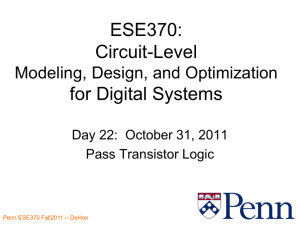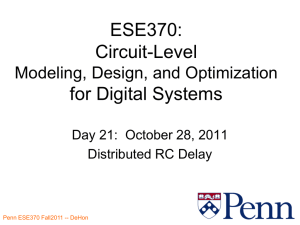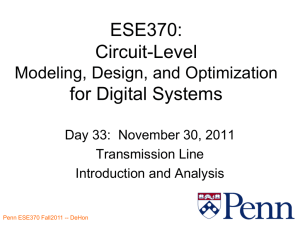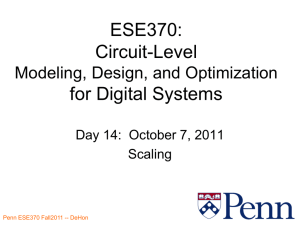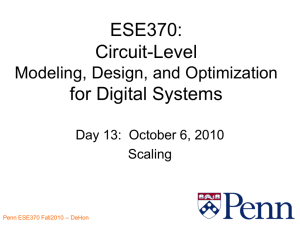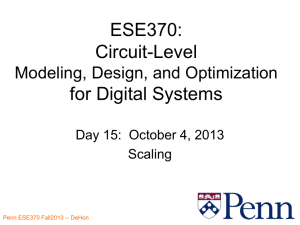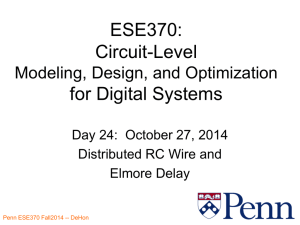ppt - SEAS
advertisement
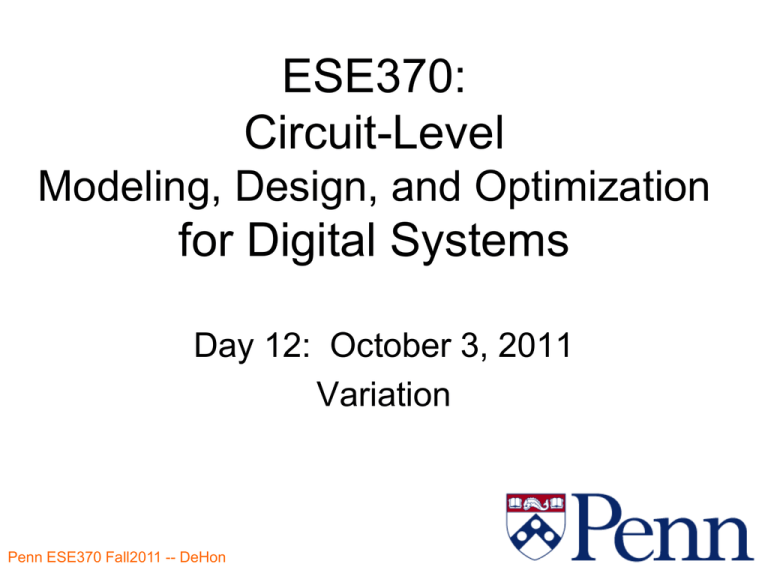
ESE370:
Circuit-Level
Modeling, Design, and Optimization
for Digital Systems
Day 12: October 3, 2011
Variation
1
Penn ESE370 Fall2011 -- DeHon
Previously
• Understand how to model
transistor behavior
• Given that we know its parameters
– Vdd, Vth, tOX, COX, W, L, NA …
CGC
CGCS
CGCB
2
Penn ESE370 Fall2011 -- DeHon
But…
• We don’t know its parameters (perfectly)
1.Fabrication parameters have error range
2.Identically drawn devices differ
3.Parameters change with environment
(e.g. Temperature)
4.Parameters change with time (aging)
Why I am more concerned with
robustness than precision.
3
Penn ESE370 Fall2011 -- DeHon
Today
• Sources of Variation
– Fabrication
– Operation
– Aging
• Coping with Variation
– Margin
– Corners
– Binning
4
Penn ESE370 Fall2011 -- DeHon
Fabrication
5
Penn ESE370 Fall2011 -- DeHon
Process Shift
•
•
•
•
Oxide thickness
Doping level
Layer alignment
Growth and Etch rates and times
– Depend on chemical concentrations
• How precisely can we control those?
• Vary machine-to-machine, day-to-day
• Impact all transistors on wafer
6
Penn ESE370 Fall2011 -- DeHon
Systematic Spatial
• Parameters change consistently across
wafer or chip based on location
• Chemical-Mechanical Polishing (CMP)
– Dishing
• Lens distortion
7
Penn ESE370 Fall2011 -- DeHon
FPGA Systematic Variation
• 65nm
• Virtex 5
Penn ESE370 Fall2011 -- DeHon
[Tuan et al. / ISQED 2010]
8
Oxide Thickness
[Asenov et al. TRED 2002]
9
Penn ESE370 Fall2011 -- DeHon
Line Edge Roughness
• 1.2mm and
2.4mm lines
From:
http://www.microtechweb.com/2d/lw_pict.htm
10
Penn ESE370 Fall2011 -- DeHon
Optical Sources
• What is the shortest wavelength of
visible light?
• How compare to 45nm feature size?
11
Penn ESE370 Fall2011 -- DeHon
Phase Shift Masking
Today’s chips use λ=193nm
Source
http://www.synopsys.com/Tools/Manufacturing/MaskSynthesis/PSMCreate/Pages/default.aspx
12
Penn ESE370 Fall2011 -- DeHon
Line Edges (PSM)
Source:
http://www.solid-state.com/display_article/122066/5/none/none/Feat/Developments-in-materials-for-157nm-photoresists
13
Penn ESE370 Fall2011 -- DeHon
Intel 65nm SRAM (PSM)
Source:
http://www.intel.com/technology/itj/2008/v12i2/5-design/figures/Figure_5_lg.gif
14
Penn ESE370 Fall2011 -- DeHon
Statistical
Dopant
Placement
15
Penn ESE370 Fall2011 -- DeHon
[Bernstein et al, IBM JRD 2006]
Random Trans-to-Trans
•
•
•
•
Random dopant fluctuation
Local oxide variation
Line edge roughness
Etch and growth rates
– Stochastic process
• Transistors differ from each other in
random ways
Penn ESE370 Fall2011 -- DeHon
16
Source: Noel Menezes, Intel ISPD2007
17
Penn ESE370 Fall2011 -- DeHon
Impact
• Changes parameters
– W, L, tOX, Vth
• Change transistor behavior
– W?
– L?
– tOX?
IDS
mn COX W
2
VGS VT
L
2
18
Penn ESE370 Fall2011 -- DeHon
Example: Vth
• Many physical effects impact Vth
– Doping, dimensions, roughness
• Behavior highly dependent on Vth
IDS
IDS
2
W
IS e
L
Penn ESE370 Fall2011 -- DeHon
mn COX W
VGS VT
L
2
VGS VT
nkT / q
VDS
kT / q
1 e 1 VDS
19
Vth Variability @ 65nm
20
Penn ESE370 Fall2011 -- DeHon
[Bernstein et al, IBM JRD 2006]
Impact of Vth Variation?
• Higher VTH?
– Not drive as strongly
– Id,sat (Vgs-VTH)2
– Performance?
IDS
mn COX W
2
VGS VT
L
2
21
Penn ESE534 Spring2010 -- DeHon
Impact Performance
• Vth Ids Delay (Ron * Cload)
22
Penn ESE370 Fall2011 -- DeHon
Impact of Vth Variation
Penn ESE370 Fall2011 -- DeHon
Think NMOS Vgs = Vdd
23
FPGA Logic Variation
• Xilinx Virtex 5
• 65nm
• Altera
Cyclone-II
• 90nm
[Tuan et al. / ISQED 2010]
Penn ESE370 Fall2011 -- DeHon
[Wong, FPT2007]
24
Impact of Vth Variation?
• Lower VTH?
– Not turn off as well leaks more
IDS
W
IS e
L
Penn ESE534 Spring2010 -- DeHon
VGS VT
nkT / q
VDS
kT / q
1 e 1 VDS
25
2004
Borkar (Intel) Micro 37 (2004)
Penn ESE370 Fall2011 -- DeHon
26
Operation
Temperature
Voltage
27
Penn ESE370 Fall2011 -- DeHon
Temperature Changes
• Different ambient environments
– January in Maine
– July in Philly
– Air conditioned machine room
• Self heat from activity of chip
• Quality of heat sink (attachment thereof)
IDS
W
IS e
L
Penn ESE370 Fall2011 -- DeHon
VGS VT
nkT / q
VDS
kT / q
1 e 1 VDS
28
Self Heating
Borkar (Intel) Micro 37 (2004)
29
Penn ESE370 Fall2011 -- DeHon
Temperature (on current?)
• High temperature
– More free thermal energy
• Easier to conduct
• Lowers Vth
– Increase rate of collision
• Lower saturation velocity
• Lower saturation voltage
• Lower peak Ids slows down
• Another reason don’t want chips to run hot
30
Penn ESE370 Fall2011 -- DeHon
Temperature (leakage?)
• High temperature Lowers Vth
IDS
W
IS e
L
Penn ESE370 Fall2011 -- DeHon
VGS VT
nkT / q
VDS
kT / q
1 e 1 VDS
31
Voltage
• Power supply isn’t perfect
• Differs from design to design
– Board to board?
– How precise is regulator?
• IR-drop in distribution
• Bounce with current spikes
32
Penn ESE370 Fall2011 -- DeHon
Aging
Hot Carrier
NBTI
33
Penn ESE370 Fall2011 -- DeHon
Hot Carriers
• Trap electrons in oxide
– Also shifts Vth
34
Penn ESE370 Fall2011 -- DeHon
NBTI
• Negative Bias Temperature Instability
– Interface traps, Holes
• Long-term negative gate-source voltage
– Affects PFET most
• Increase Vth
• Partially recoverable?
• Temperature dependent
Penn ESE370 Fall2011 -- DeHon
[Stott, FPGA2010]
35
Measured Accelerated Aging
(Cyclone III, 65nm FPGA)
Penn ESE370 Fall2011 -- DeHon
[Stott, FPGA2010]
36
Coping with Variation
37
Penn ESE370 Fall2011 -- DeHon
Variation
• See a range of parameters
– L: Lmin – Lmax
– Vth: Vth,min – Vth,max
38
Penn ESE370 Fall2011 -- DeHon
Impact of Vth Variation
• Higher VTH
– Not drive as strongly
– Id,sat (Vgs-VTH)2
• Lower VTH
– Not turn off as well leaks more
IDS
W
IS e
L
Penn ESE534 Spring2010 -- DeHon
VGS VT
nkT / q
VDS
kT / q
1 e 1 VDS
39
Variation
• Margin for expected variation
• Must assume Vth can be any value in range
– Speed assume Vth slowest value
Ion,min=Ion(Vth,max)
Probability Distribution
Id,sat (Vgs-Vth)2
VTH
40
Penn ESE370 Fall2011 -- DeHon
Gaussian Distribution
From: http://en.wikipedia.org/wiki/File:Standard_deviation_diagram.svg
41
Penn ESE534 Spring2010 -- DeHon
Impact
• Given
– Vth,nom = 250mV
– Sigma 25mV
• What maximum Vth should expect to
see for a circuit of
– 100 transistors?
– 1000 transistors?
– 109 transistors?
42
Penn ESE370 Fall2011 -- DeHon
Variation
• See a range of parameters
– L: Lmin – Lmax
– Vth: Vth,min – Vth,max
• Validate design at extremes
– Work for both Vth,min and Vth,max ?
– Design for worst-case scenario
43
Penn ESE370 Fall2011 -- DeHon
Margining
• Also margin for
– Temperature
– Voltage
– Aging: end-of-life
44
Penn ESE370 Fall2011 -- DeHon
Process Corners
• Many effects independent
• Many parameters
• With N parameters,
– Look only at extreme ends (low, high)
– How many cases?
• Try to identify the {worst,best} set of
parameters
– Slow corner of design space, fast corner
• Use corners to bracket behavior
Penn ESE370 Fall2011 -- DeHon
45
Range of Behavior
Probability Distribution
• Still get range of performances
• Any way to exploit the fact some are faster?
Delay
46
Penn ESE370 Fall2011 -- DeHon
Probability Distribution
Speed Binning
Sell
Premium
Sell
Sell
nominal cheap
Discard
Delay
47
Penn ESE370 Fall2011 -- DeHon
Admin
• HW4 out
– All but question 5 should be approachable
now
• Andre out Tuesday
• Andre back for lecture on Wednesday
– Talk about layout … HW4.Q5
• First midterm W after break
48
Penn ESE370 Fall2011 -- DeHon
Idea
• Parameters Approximate
• Differ
– Chip-to-chip, transistor-to-transistor, over
time
• Robust design accommodates
– Tolerance and Margins
– Doesn’t depend on precise behavior
Penn ESE370 Fall2011 -- DeHon
49
